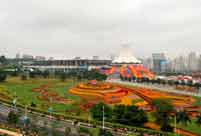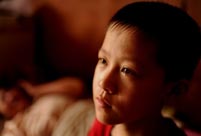 |
| An elderly woman at the narrow Baimixiejie Hutong. (China Daily/Zou Hong) |
According to Sun, more than 500 families among the total number of 1,700 there were willing to move out and were given compensation for new housing.
"For those who didn't want to leave, the local government paid to improve their living conditions, such as building more public toilets, installing natural gas pipes and renovating old houses," says Sun.
Ancient legacy
The water area of Shichahai was called Haizi before the Yuan Dynasty (1279-1368). With the nearby Beihai Lake becoming an imperial back garden, around 20 temples were built in the area of Shichahai.
In its heyday, Shichahai, which is composed of three lakes, Qianhai, Houhai and Xihai, formed the northern part of the water system of the Grand Canal, which connected Beijing with other cities of China. Wooden boats carried goods from southern China into the imperial capital, making the area a busy commercial center.
The location near the Forbidden City has long attracted many senior officials and celebrities to the area. As a rare waterfront in the capital, it has been a sanctuary for local residents from the daily hustle and bustle for centuries.


 DPRK holds military parade to mark 65th founding anniv.
DPRK holds military parade to mark 65th founding anniv. Highlights of MAKS 2013 Int'l Aviation and Space Show
Highlights of MAKS 2013 Int'l Aviation and Space Show  10th China-ASEAN Expo opens in Nanning
10th China-ASEAN Expo opens in Nanning Eagle Boy takes to sky to break another record
Eagle Boy takes to sky to break another record 12-year-old boy becomes pillar of the family
12-year-old boy becomes pillar of the family Eye-gouged boy receives blind rehabilitation in Shanxi
Eye-gouged boy receives blind rehabilitation in Shanxi Top 10 naked hotels in the world
Top 10 naked hotels in the world The most gorgeous Chinese women in the eyes of foreigners
The most gorgeous Chinese women in the eyes of foreigners A collection of bizarre rooftop buildings around China
A collection of bizarre rooftop buildings around China Residences of the royal house of Savoy
Residences of the royal house of Savoy China's frigate 'Bengbu'in fire training
China's frigate 'Bengbu'in fire training Fresh students 'forced' to register in university independently
Fresh students 'forced' to register in university independently 2013 Taiwan Int'l Tourism Expo kicks off in Taipei
2013 Taiwan Int'l Tourism Expo kicks off in Taipei Photo story: Take a gap year
Photo story: Take a gap year Nokia's Global Headquarters: visiting a declining empire
Nokia's Global Headquarters: visiting a declining empireDay|Week|Month